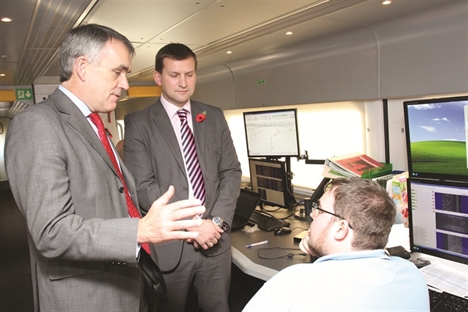01.01.13
Plain Line Pattern Recognition
Source: Rail Technology Magazine Dec/Jan 2013
RTM talks to Network Rail’s Tim Flower about a track fault-finding technique heralded as ‘the future of continuously welded track inspection’.
Plain line pattern recognition (PLPR) brings track inspection into the 21st century, Network Rail says – as senior industry figures saw for themselves when the organisation’s New Measurement Train (NMT) called at St Pancras to show off the new kit.
The genesis of the idea is about as old as the NMT itself, which originally had cameras fitted to its underside on the ‘flying carpet’ – the hydraulic system that kept the cameras lined up with the railhead so the image recognition always knew where the railhead was to start its pattern recognition.
But problems with that system led the team to swap those cameras for ones by Omnicom in 2007-8, which led to a pilot project with Loughborough University – which morphed into Rail Vision. After their proof-of-concept, it became a full-blown Network Rail project.
Although the idea of PLPR exists elsewhere around the world – including in Switzerland, at a Rio Tinto mine in Brazil, and a metro system in South Korea – Network Rail programme manager Tim Flower told RTM that the UK solution is much broader. He explained: “It’s been used before, but only really on homogenous railways, with all the same fastener type – generally fairly new railways as well. The idea has been used before, but ours is a far wider-ranging roll-out of the idea.”
Omnicom Engineering and Network Rail won ‘Innovation of the Year’ at the National Rail Awards for OmniVision, a key part of the PLPR project, and it is now being fitted to four other trains.
Explaining the different faults it can be used to spot, Flower said: “For fasteners, stereo imaging is used – the top-down and diagonal cameras. The diagonal cameras back up what the top-down cameras have found. It’s a secondary check.
“For joints, we don’t do any pattern recognition using the diagonal cameras, but it provides us with additional information when we decide we’re going to review a joint: we review a joint when it goes to a certain threshold on its dip angle. Then the on-train inspectors are able to review those joints using the diagonal cameras as well as the top-down.
“The four-foot camera is solely used to review the track condition when we’ve found pattern recognition faults.
“We haven’t yet started using the thermal cameras: we put those on to future-proof the system. The aspiration with those is that we use them to look for heating up of the rail, which can lead to arc damage and things like that. We’ve got a conductor rail measurement system that does a similar operation, so we’ll also need to integrate with that.
“The other operation was looking at measuring the rail temperature and overlay with the joint gap, on jointed track: that’s not part of our scope yet, but the next iteration will be to look at jointed track.”
Flower said: “We’re currently running at about 20 things for the on-train inspector to look at per mile, which we call candidates. Of those, about 30-35% get verified as defective, but a high proportion of those are ballast obscuring the fasteners. So, we’re developing the system to minimise the number of times that gets presented to the on-train inspectors. It basically cuts down the workload.”
PLPR is going to be run as a service offered by Network Rail’s Asset Information team to the individual routes. “It’s not mandated, but it is highly encouraged,” Flower said.
“Andy Jones, our head of track engineering, says it gives better assurance; a positive confirmation that every piece of track has been inspected, with the record in a computer system so it’s very auditable. The buy-in has been really good – ‘when are we getting it’ is what we get asked a lot.
“It’s part of our overall strategy to remove people from red-zone working, which obviously track inspection can form quite a big part of. Essentially, this gets people away from moving trains. As we evolve the system, hopefully we’ll be able to roll it out to S&C, which will bring further benefits.”
Robin Gisby, Network Rail’s managing director of network operations, said: “Plain line pattern recognition is part of a wider strategy to use technology to improve the network and reduce our costs.
“By gaining greater knowledge about our infrastructure we will be able to free resources up to work on crucial parts of the network, such as the station throat at St Pancras, rather than rural branch lines that may not need it.
“It also means that when we do have to work on the branch line, we know what we are going to find.
“We can see problems emerging and go in and fix them before they become a problem.”
Speaking on Network Rail’s New Measurement Train as it called at St Pancras, the company’s director of infrastructure maintenance, Mac Andrade, said: “St Pancras was opened in 1869 and we haven’t changed the way we do track inspection since then.
“What we want to do is bring our railway into the 21st century and reduce the exposure of our people to the danger of working on the live railway. The train does not only record the information but it filters it, prioritises it and stops us from being overwhelmed by data.”
Tell us what you think – have your say below, or email us directly at [email protected]
